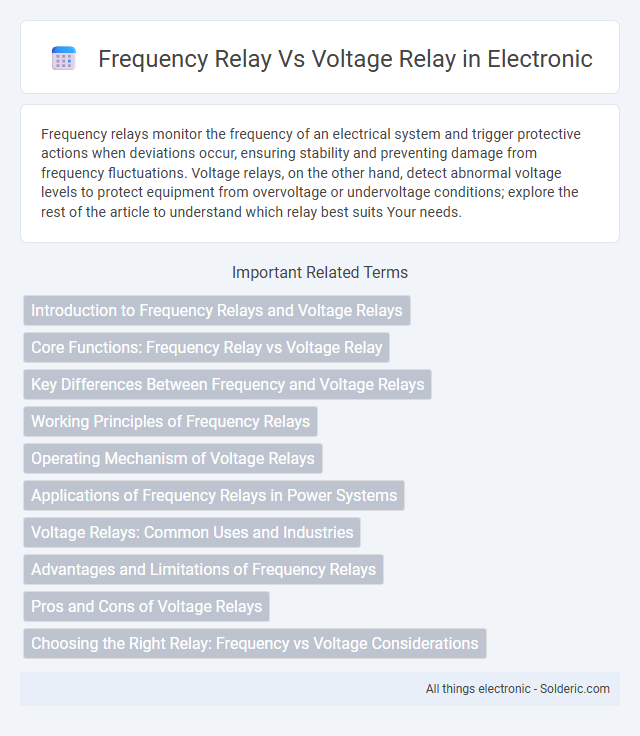Frequency relays monitor the frequency of an electrical system and trigger protective actions when deviations occur, ensuring stability and preventing damage from frequency fluctuations. Voltage relays, on the other hand, detect abnormal voltage levels to protect equipment from overvoltage or undervoltage conditions; explore the rest of the article to understand which relay best suits Your needs.
Comparison Table
| Feature | Frequency Relay | Voltage Relay |
|---|---|---|
| Function | Monitors system frequency deviations | Monitors voltage level deviations |
| Application | Protects against overfrequency and underfrequency conditions | Protects equipment from overvoltage and undervoltage |
| Measurement Parameter | Frequency (Hz) | Voltage (Volts) |
| Typical Use Cases | Power plants, grid frequency stability, load shedding | Transformers, motors, and voltage-sensitive devices protection |
| Response Time | Fast response to frequency changes | Rapid detection of voltage fluctuations |
| Threshold Settings | Set for specific frequency limits (e.g., 50 Hz +- 1 Hz) | Set for specific voltage levels (e.g., 230V +- 10%) |
| Output | Trip or alarm signal to control systems | Trip or alarm signal to control systems |
Introduction to Frequency Relays and Voltage Relays
Frequency relays monitor electrical system frequency, ensuring stability by detecting deviations from preset frequency limits to protect equipment from damage. Voltage relays measure voltage levels, activating or deactivating circuits when voltage exceeds or falls below specified thresholds to maintain system reliability. Your choice between frequency relays and voltage relays depends on whether frequency stability or voltage control is paramount in your electrical protection strategy.
Core Functions: Frequency Relay vs Voltage Relay
Frequency relays monitor and control the frequency of electrical power systems, ensuring stability by detecting deviations from set frequency thresholds to protect equipment and maintain system reliability. Voltage relays safeguard electrical circuits by sensing voltage levels, activating protective measures when voltage exceeds or falls below preset limits to prevent damage due to under-voltage or over-voltage conditions. Both relays play crucial roles in power system protection but focus on distinct electrical parameters critical for maintaining operational integrity.
Key Differences Between Frequency and Voltage Relays
Frequency relays monitor and respond to changes in the power system's frequency, protecting equipment from frequency deviations that can cause instability, while voltage relays detect voltage fluctuations, ensuring the voltage remains within safe operating limits. Your choice between frequency and voltage relays depends on whether the primary concern is frequency stability or voltage regulation in your electrical network. Frequency relays act during abnormal frequency conditions, whereas voltage relays trigger protection during undervoltage or overvoltage events.
Working Principles of Frequency Relays
Frequency relays operate by continuously monitoring the electrical system's frequency and triggering protective actions when deviations exceed preset thresholds, typically using electromechanical or electronic sensing methods. They measure the difference between the actual frequency and the reference frequency, activating switching mechanisms to isolate or protect equipment during abnormal frequency conditions. Understanding the working principles of frequency relays helps you ensure stable power system performance by preventing damage caused by overfrequency or underfrequency events.
Operating Mechanism of Voltage Relays
Voltage relays operate by continuously monitoring the voltage levels in an electrical circuit and activating when the voltage exceeds or drops below a preset threshold. These relays rely on electromagnetic coils or solid-state sensors to detect voltage fluctuations, triggering a switching action that protects equipment from overvoltage or undervoltage conditions. Understanding the operating mechanism of voltage relays helps you ensure reliable voltage regulation and safeguard your electrical systems effectively.
Applications of Frequency Relays in Power Systems
Frequency relays are essential in power systems for detecting abnormal frequency deviations, which help prevent system instability and equipment damage. They are widely used for load shedding, generator protection, and underfrequency load control to maintain grid reliability during disturbances. Unlike voltage relays that monitor voltage levels, frequency relays specifically safeguard against frequency fluctuations caused by imbalances between power supply and demand.
Voltage Relays: Common Uses and Industries
Voltage relays are commonly used in industries such as power generation, electrical distribution, and manufacturing to monitor and protect electrical equipment by detecting abnormal voltage levels. These relays help prevent damage from overvoltage or undervoltage conditions, ensuring the stability and safety of electrical systems. Your operational efficiency benefits from the reliable voltage regulation provided by voltage relays in critical applications like motor control and transformer protection.
Advantages and Limitations of Frequency Relays
Frequency relays offer precise protection by detecting abnormal frequency deviations in power systems, enabling rapid response to under-frequency or over-frequency events and preventing equipment damage. Their main advantage lies in their sensitivity to changes in system stability and load variations, enhancing grid reliability and minimizing blackout risks. However, limitations include potential false trips during transient disturbances and the need for accurate frequency measurement, which may complicate installation and maintenance costs.
Pros and Cons of Voltage Relays
Voltage relays offer precise monitoring and protection by detecting abnormal voltage levels, which helps safeguard electrical equipment from damage caused by overvoltage or undervoltage conditions. They are relatively simple, cost-effective, and quick to respond, but their main limitation is that they cannot detect frequency variations, potentially overlooking frequency-related system issues. Your choice depends on whether voltage stability or frequency control is more critical for your specific electrical system needs.
Choosing the Right Relay: Frequency vs Voltage Considerations
Choosing the right relay involves understanding the specific demands of your electrical system, whether frequency or voltage monitoring is critical. Frequency relays protect equipment by detecting abnormal frequency fluctuations, preventing damage due to over- or under-frequency conditions, while voltage relays safeguard against voltage irregularities such as overvoltage, undervoltage, or phase imbalances. Your selection should prioritize the relay type that aligns with your system's primary vulnerability, ensuring optimal protection and operational stability.
Frequency Relay vs Voltage Relay Infographic

 solderic.com
solderic.com